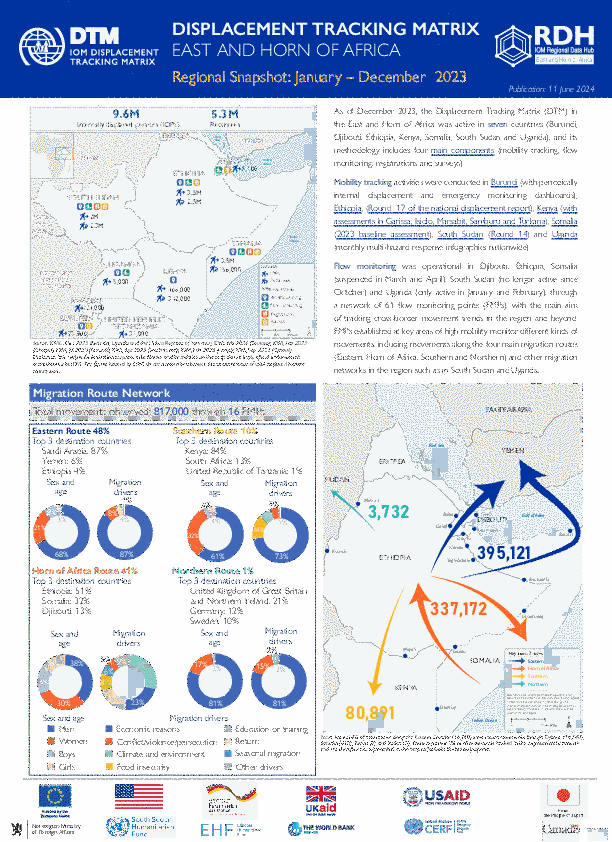-
Countries
-
Data and Analysis
-
Special Focus
-
Crisis Responses
Flow Monitoring

Contact
DTM Europe, DTMMediterranean@iom.int
Language
English
Location
Republic of Moldova
Period Covered
Jan 01 2024
Mar 31 2024
Activity
- Survey
- Return Intention
- Flow Monitoring
IOM’s Displacement Tracking Matrix (DTM) collects data on Ukrainian nationals and Third-Country Nationals (TCNs) that were crossing back to Ukraine from or through the Republic of Moldova, either for temporary stay or prospective return. The survey focuses on the return intentions, duration of displacement, destinations, assistance, and experiences of unequal treatment of the respondents. A total of 1,800 surveys were collected between January and March 2024.
Key findings:
- 87% of Ukrainian respondents planned to go for a short visit, 7% intended to stay in Ukraine (prospective returnees), while 6% were not sure about their intentions.
- The majority (69%) been residing in the Republic of Moldova, 9% in Romania, 5% in Germany. The remaining 17% stayed in other countries.
- 83% were going back to their Oblast of origin, while 17% were going back to a different Oblast.
- 43% had been displaced between January and June 2022.
- 67% crossed back to Ukraine twice or more since 2022. 10% crossed more than 10 times.
- 79% of prospective returnees and 91% of short-term visitors reported having received assistance since their displacement.
- Main priority needs that were cited by respondents include financial support (43%), medicine and health services (27%) and personal safety and security (22%).
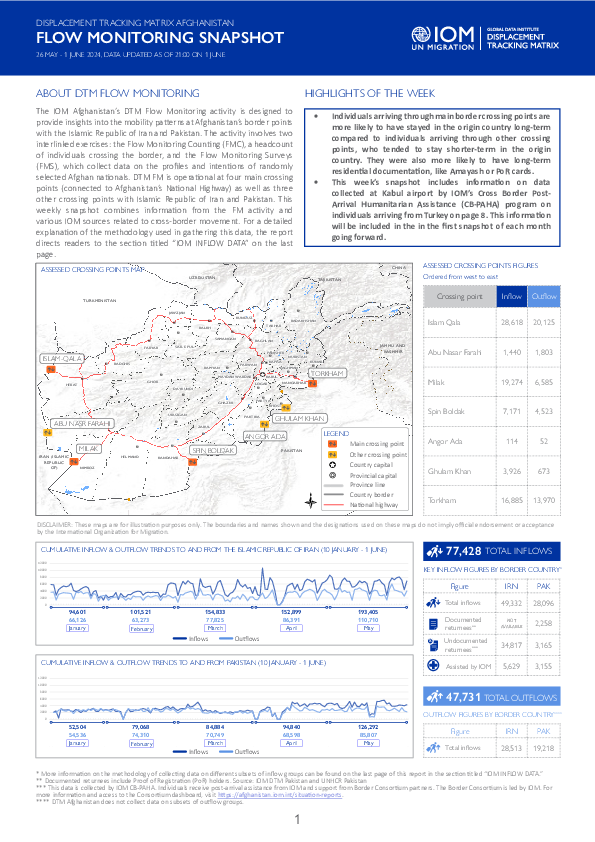
Contact
DTMAfghanistan@iom.int
Language
English
Location
Afghanistan
Period Covered
May 26 2024
Jun 01 2024
Activity
- Survey
- Flow Monitoring Survey
- Flow Monitoring
The IOM Afghanistan’s DTM Flow Monitoring activity is designed to provide insights into the mobility patterns at Afghanistan’s border points with the Islamic Republic of Iran and Pakistan. The activity involves two interlinked exercises: the Flow Monitoring Counting (FMC), a headcount of individuals crossing the border, and the Flow Monitoring Surveys (FMS), which collect data on the profiles and intentions of randomly selected Afghan nationals. DTM FM is operational at four main crossing points (connected to Afghanistan’s National Highway) as well as three other crossing points with Islamic Republic of Iran and Pakistan. This weekly snapshot combines information from the FM activity and various IOM sources related to cross-border movement. For a detailed explanation of the methodology used in gathering this data, the report directs readers to the section titled “IOM INFLOW DATA” on the last page.
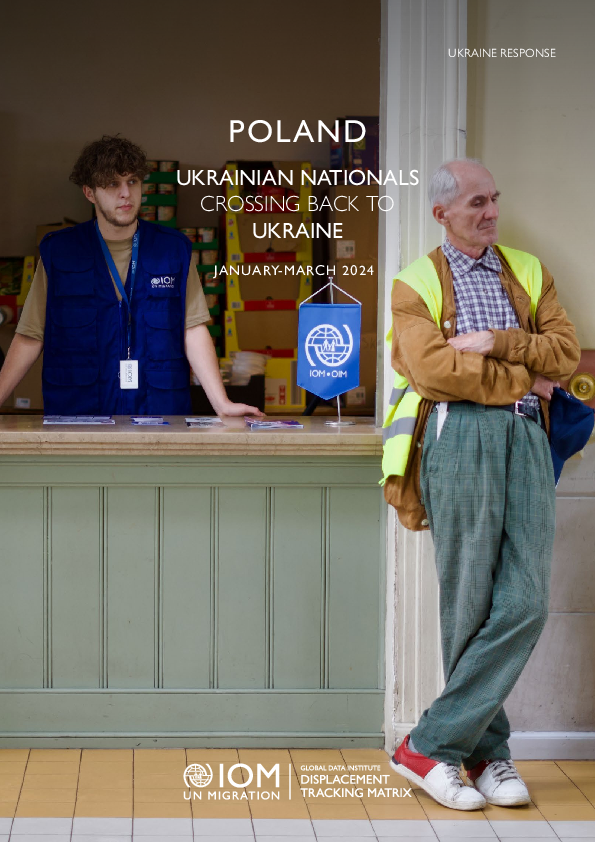
Contact
DTM Europe, DTMMediterranean@iom.int
Language
English
Location
Poland
Period Covered
Jan 01 2024
Mar 31 2024
Activity
- Survey
- Return Intention
- Flow Monitoring
IOM’s Displacement Tracking Matrix (DTM) collected data on Ukrainian nationals and Third-Country Nationals (TCNs) who crossed back to Ukraine from Poland, either for a temporary stay or permanent return after a period of displacement abroad. The survey focuses on the return intentions, duration of displacement, destinations, assistance, and experiences of discrimination of 361 Ukrainian respondents surveyed between January and March 2024.
As of December 2023, the Displacement Tracking Matrix (DTM) in the East and Horn of Africa was active in seven countries (Burundi, Djibouti, Ethiopia, Kenya, Somalia, South Sudan and Uganda), and its methodology includes four main components (mobility tracking, flow monitoring, registrations and surveys).
Mobility tracking activities were conducted in Burundi (with periodic internal displacement and emergency monitoring dashboards), Ethiopia, (Round 17 of the national displacement report), Kenya (with assessments in Garissa, Isiolo, Marsabit, Samburu and Turkana), Somalia (2023 baseline assessment), South Sudan (Round 14) and Uganda (monthly multi-hazard response infographics nationwide).
Flow monitoring was operational in Djibouti, Ethiopia, Somalia (suspended in March and April), South Sudan (no longer active since
October) and Uganda (only active in January and February), through a network of 61 flow monitoring points (FMPs), with the main aim of tracking cross-border movement trends in the region and beyond. FMPs established at key areas of high mobility monitor different kinds of movements, including movements along the four main migration routes (Eastern, Horn of Africa, Southern and Northern) and other migration networks in the region such as in South Sudan and Uganda.
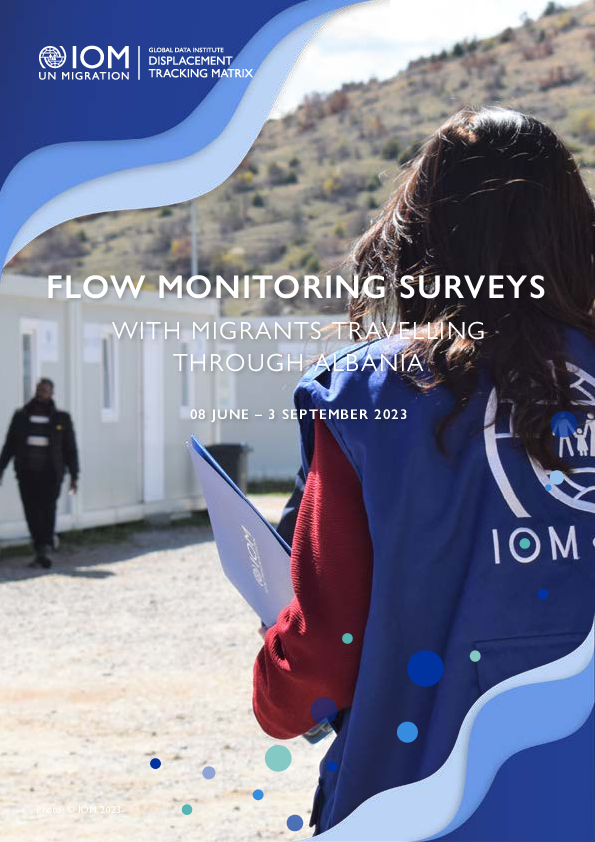
Contact
DTM Europe, DTMMediterranean@iom.int
Language
English
Location
Albania
Period Covered
Jun 08 2023
Sep 03 2023
Activity
- Survey
- Flow Monitoring
This report presents the results of the second round of the Displacement Tracking Matrix (DTM) Flow Monitoring Surveys (FMS) implemented in Albania. The data was collected across Albania from 8 June to 3 September 2023, with a total of 128 individual respondents.
FMS provides a snapshot of the profiles, experiences and needs of migrants transiting through Albania. The survey asks questions on demographics, education and employment backgrounds, the circumstances of the migration journey and migration factors, as well as future intentions.
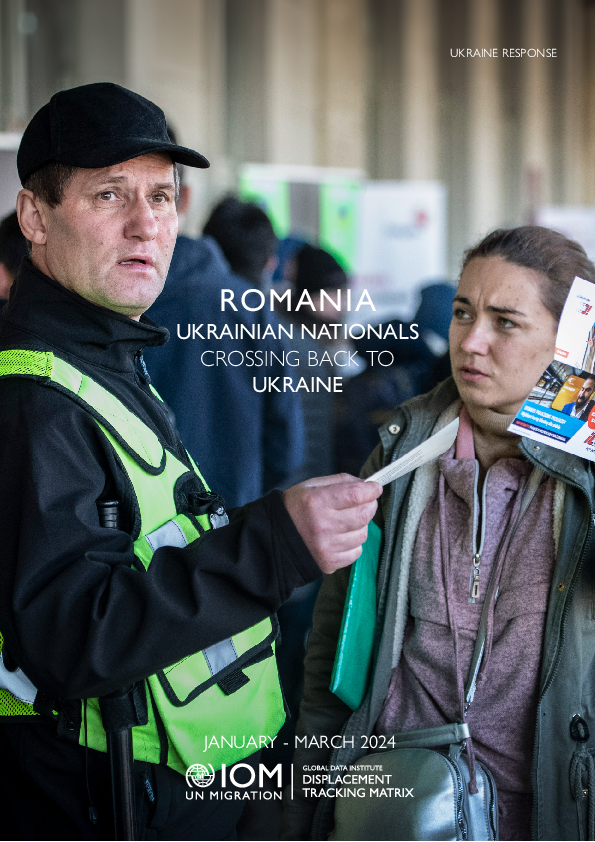
Contact
DTM Europe, DTMMediterranean@iom.int
Language
English
Location
Romania
Period Covered
Jan 01 2024
Mar 31 2024
Activity
- Survey
- Return Intention
- Flow Monitoring
IOM’s Displacement Tracking Matrix (DTM) collected data on Ukrainian nationals and TCNs (resided in Ukraine before 24 February 2022) that were crossing back to Ukraine from or through Romania, either temporarily or permanently. The survey focuses on the return intentions, duration of displacement, destinations, assistance, and experiences of discrimination of respondents. A total of 1,298 surveys were collected between January and March 2024. Among these, less than one per cent (n=11) were completed by TCNs, while the vast majority, comprising over 99 per cent (n=1,287), were completed by Ukrainian nationals. The analysis presented in this report is based on the responses provided by Ukrainian nationals.
Before crossing back into Ukraine, individuals commonly stayed in Romania (57%), other EU countries (36%) or non-EU countries (6%). Aside from Romania, other countries of residence were Bulgaria (18%), Germany (6%), Italy (4%) or Turkey (3%).
The travel intentions of the surveyed Ukrainian nationals show that most respondents (63%) were “short-term visitors”, while 15 per-cent were prospective returnees. Another 22 per cent were not sure regarding their visit period. Also, most UA citizens were travelling back to their oblast of origin (985%), with most respondents originating from Odeska, Chernivetska, City of Kiyv Mykolaivska or Kersonska.
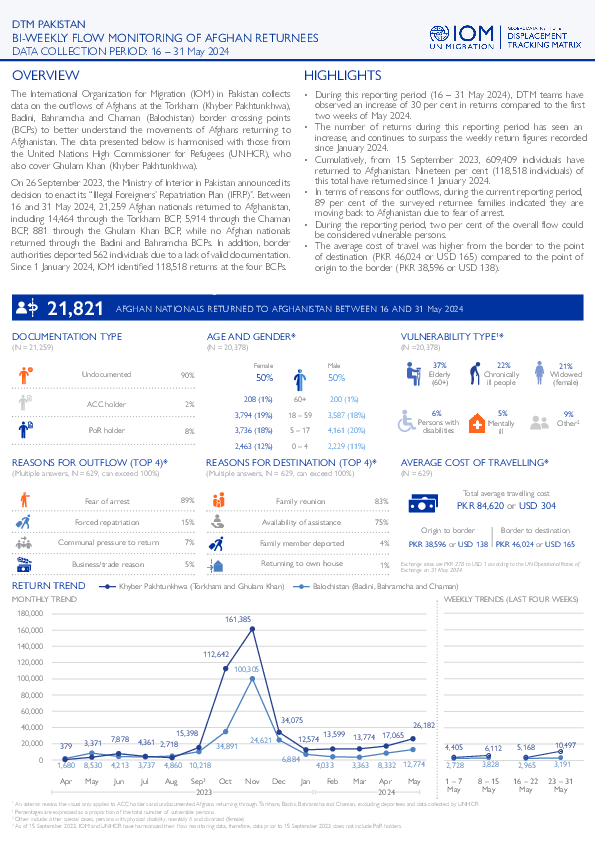
Contact
DTM Pakistan, DTMPakistan@iom.int
Language
English
Location
Pakistan
Period Covered
May 16 2024
May 31 2024
Activity
- Flow Monitoring
The International Organization for Migration (IOM) in Pakistan collects data on the outflows of Afghans at the Torkham (Khyber Pakhtunkhwa), Badini, Bahramcha and Chaman (Balochistan) border crossing points (BCPs) to better understand the movements of Afghans returning to Afghanistan. The data presented below is harmonised with those from the United Nations High Commissioner for Refugees (UNHCR), who also cover Ghulam Khan (Khyber Pakhtunkhwa).
On 26 September 2023, the Ministry of Interior in Pakistan announced its decision to enact its “Illegal Foreigners’ Repatriation Plan (IFRP)”. Between 16 and 31 May 2024, 21,259 Afghan nationals returned to Afghanistan, including 14,464 through the Torkham BCP, 5,914 through the Chaman BCP, 881 through the Ghulam Khan BCP, while no Afghan nationals returned through the Badini and Bahramcha BCPs. In addition, border authorities deported 562 individuals due to a lack of valid documentation. Since 1 January 2024, IOM identified 118,518 returns at the four BCPs.
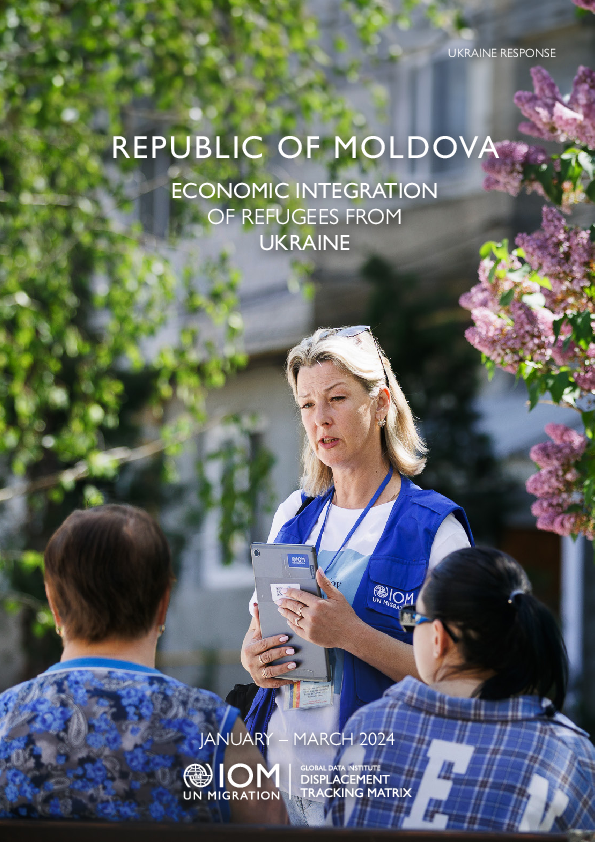
Contact
DTM Europe, DTMMediterranean@iom.int
Language
English
Location
Republic of Moldova
Period Covered
Jan 01 2024
Mar 31 2024
Activity
- Survey
- Flow Monitoring
The IOM’s Displacement Tracking Matrix collected data through Surveys with Refugees in the Ukraine Response region from January to March 2024. In the Republic of Moldova, a total of 1,507 surveys were collected. This report focuses on the economic integration of the respondents, delving deeper into their employment profiles, skills, and prospects for participation in the local labour market.
Key findings:
- 82% of the respondents possessed Temporary Protection Status. Others reported having: irregular status (13%), refugee status (2%), or residence permits (3%).
- 87% of the active respondents were employed in Ukraine before displacement. After being displaced in the Republic of Moldova employment rates were 49% among the respondents that actively participated in the labour market.
- Among employed respondents, 37% had an official working contract in the Republic of Moldova and 30% were working based on a verbal agreement. The remaining 33% had a remote working contract in another country.
- Two-thirds (66%) of men and 47% of women were satisfied with their working arrangement.
- Respondents reported an average monthly expenditure of 285 euro on rent and 110 on utilities.
- 44% of the surveyed households had a total monthly income of less than 400 euros.
- 65% reported receiving an average of 300 euros monthly in remittances from Ukraine.
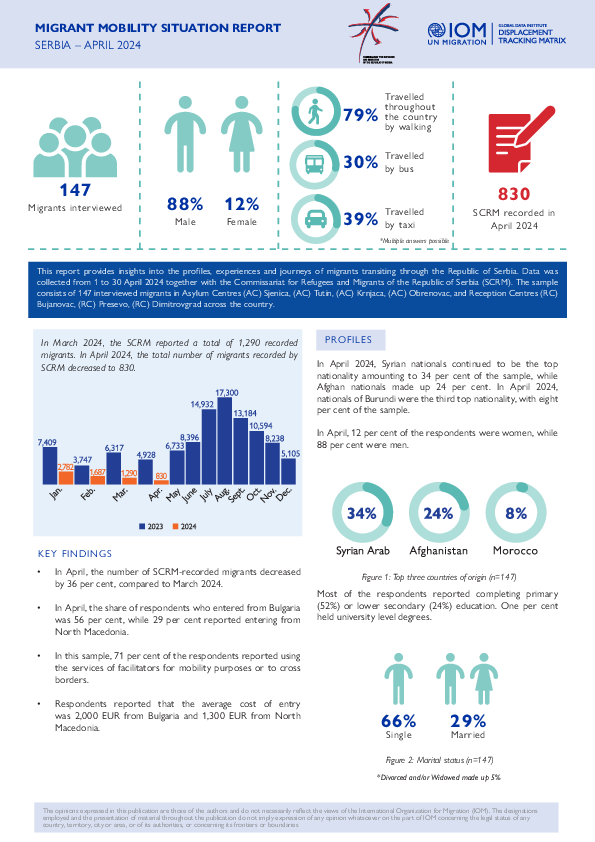
Contact
DTM Europe, DTMMediterranean@iom.int
Language
English
Location
Serbia
Period Covered
Apr 01 2024
Apr 30 2024
Activity
- Survey
- Flow Monitoring
This report provides insights into the profiles, experiences and journeys of migrants transiting through the Republic of Serbia. Data was collected from 1 to 30 April 2024 together with the Commissariat for Refugees and Migrants of the Republic of Serbia (SCRM). The sample consists of 147 interviewed migrants in Asylum Centres (AC) Sjenica, (AC) Tutin, (AC) Krnjaca, (AC) Obrenovac, and Reception Centres (RC) Bujanovac, (RC) Presevo, (RC) Dimitrovgrad across the country.

Contact
DTM Europe, DTMMediterranean@iom.int
Language
English
Location
Slovakia
Period Covered
Jan 01 2024
Mar 31 2024
Activity
- Survey
- Return Intention
- Flow Monitoring
IOM’s Displacement Tracking Matrix (DTM) collected data on Ukrainian nationals and Third-Country Nationals (TCNs) that crossed back to Ukraine from or through Slovakia, either temporarily or permanently. The survey focuses on the return intentions, duration of displacement, destinations, assistance, and experiences of discrimination of respondents. A total of 1,335 surveys were collected between January and March 2024.
Key findings:
- 27% of Ukrainian respondents intend to stay in Ukraine (prospective returnees), while 68% plan to go for a short visit.
- The share of those intending to return to Ukraine is higher among men than women (49% vs 25%). Women are more likely to be crossing into Ukraine for a short visit than men (69% vs 44%).
- Most of the short-term visitors plan to stay in their own home in Ukraine (78% overall), while others report to be going to their relatives’ homes (10%), finding other private solutions (7%) or staying with friends (4%). The share of those planning to stay at home is higher among prospective returnees (98%) than among short-term visitors (78%).
- Reasons for returning for prospective returnees include: visit relatives or close friends (75%), meet with family members (6%), reunite with their family (6%).
- Reasons for returning for short-term visitors include: visit family members (76%), healthcare (26%), reunite with family (21%).
- 64% of the Ukrainian nationals originate from seven regions in Ukraine: Zakarpatska (21%), Kyiv (13%), Kharkivska (8%), Dnipropetrovska (8%), Odeska (6%), Zaporizka (3%), and Mykolaivska (3%). The remaining 36% of respondents come from another 20 regions across Ukraine.
Pagination
- Previous page
- Page 7
- Next page
